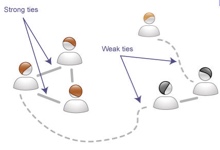 I found McGilchrist’s divided brain model compelling on its own neurological bases alone, but what really sold me on its importance is the number of instances where it explains cultural phenomena. I will being using my blog to post examples when I come across them. Today’s post comments on the influential strong/weak ties model of Mark Granovetter. His work remains one of the most cited in the field of sociology (Granovetter, M.S. “The Strength of Weak Ties” Am. J. Sociol. 78 (6): 1360–80). Here is a key paragraph:
I found McGilchrist’s divided brain model compelling on its own neurological bases alone, but what really sold me on its importance is the number of instances where it explains cultural phenomena. I will being using my blog to post examples when I come across them. Today’s post comments on the influential strong/weak ties model of Mark Granovetter. His work remains one of the most cited in the field of sociology (Granovetter, M.S. “The Strength of Weak Ties” Am. J. Sociol. 78 (6): 1360–80). Here is a key paragraph:
From the individual’s point of view, then, weak ties are an important resource in making possible mobility opportunity. Seen from a more macroscopic vantage, weak ties play a role in effecting social cohesion. When a man changes jobs, he is not only moving from one network of ties to another, but also establishing a link between these. Such a link is often of the same kind which facilitated his own movement. Especially within professional and technical specialties which are well defined and limited in size, this mobility sets up elaborate structures of bridging weak ties between the more coherent clusters that constitute operative networks in particular locations. Information and ideas thus flow more easily through the specialty, giving it some “sense of community,” activated at meetings and conventions. Maintenance of weak ties may well be the most important consequence of such meetings.
In a nutshell, he argued that weak ties among “acquaintances” was a key factor in holding society (or large organizations) together. Strong ties among “friends” impeded the flow of information across the boundaries of small tightly bound groups, information that serves to form bonds among the smaller units. He wrote, “… these clumps [strong ties networks] would not, in fact, be connected to one another at all were it not for the existence of weak ties (p. 1363). Individuals with multiple weak links will fare better in a social network that those with only a few weak links. Further, he wrote that increasing specialization increases the need for weak ties in providing cohesive forces.
How does this fit the divided brain model? Ties are evidence of connections. Granovetter’s nomenclature obscures the nature of these ties. Weak ties are evidence of the right-brain in action. They are personal, context-dependent, and alive. Specialization fits the abstractive character of the left-brain. Individuals are decontextualized and objectified. When members of the organization/society are dominantly left-brainers, organization stability and internal cohesiveness will be weakened. The point I am making in this brief analysis is that Granovetter’s work can be understood via the divided-brain model. All I want to do in these posts is continue to build the case that McGilchrist’s work has great generality and explanatory/design power.